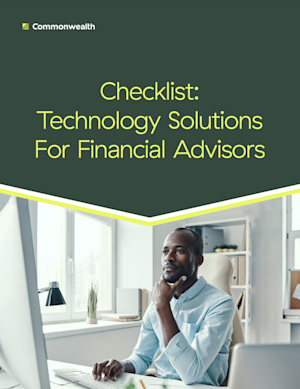Imagine this: Your client wants to buy a new home in the next year. You review their portfolio and determine which assets you can sell to free up money for a downpayment. After developing a proposal, you present it only to learn they already have the money saved up in their checking account (where it’s earning very little interest!).
This might be a bit extreme, but you get the idea: seeing assets held away (i.e., not under your management) can profoundly affect the decisions you make about the assets you do manage. And it can enable you to provide a better overall client experience.
Let’s take a deeper dive into why seeing outside assets is important and how you can uncover those assets. Plus, we’ll explore the technology solutions that can help you guide your client’s financial future.
A Potential Win-Win for Everyone
As the above example illustrates, seeing all your client’s assets (and liabilities), instead of just the portion you manage, will better equip you to create the most effective financial plan and help your client meet their goals. How?
According to my colleague, Krista Teegarden, senior advanced planning consultant, understanding everything your client holds will allow you to:
-
Better allocate the assets you manage
-
Identify any overlap or gaps in their larger portfolio
-
Minimize potential tax liabilities
-
Have better financial planning discussions
And it may present opportunities for you as well. Once you see what other assets your client holds, you may be able to persuade them that the money in their checking account could provide better returns if managed by you. Or that it may be prudent to consolidate all their investment accounts under one advisor (preferably you).
How to Uncover Your Client’s Outside Assets
The big question, of course, is how do you learn about the assets your client holds elsewhere? Easy. Just ask! If you’re bringing on a new client, make it part of the onboarding process. If you have an established relationship and don’t have the full view of your client’s financial life, ask about it at your next review meeting.
You can start with a few simple questions:
-
Do you have other assets we haven’t talked about? Be sure to ask about checking and savings accounts, real estate and property, and even insurance policies.
-
How much debt do you currently hold? You’ll want to uncover everything from their mortgage and car loans to credit card debt.
-
Do you work with another financial advisor? This may be a tricky question, as you don’t want to appear like you’re competing for those assets (even if you are!).
Then, discuss why this information is important to you and how it will benefit them. Teegarden suggests that by seeing those additional assets and liabilities, you can:
-
Create a more effective financial plan that aligns with their goals. A holistic financial plan needs to take into account all of your client’s assets and liabilities.
-
Ensure that all assets are working together to achieve those goals. Allocating the assets you manage may change depending on what other assets your client holds.
-
Make more personalized recommendations and investment decisions. Your investment decisions may change if, for example, your client already has money saved elsewhere for an emergency fund or they have an employer-sponsored 401(k) plan invested primarily in equities.
-
Find ways to minimize their tax liabilities. Taking all assets into account will allow you to determine what their tax burden may be and provide opportunities to minimize it.
How Technology Has Changed the Game
Once upon a time, if you wanted to see your client’s outside assets, you needed to ask for statements, plug the numbers into a spreadsheet (or a paper ledger if we’re going way back), and then update those numbers every month. This was a cumbersome task, and it may have been easier to simply get a ballpark figure to work with.
Fortunately, the latest technology can make this process much more efficient. Most portfolio management systems allow advisors and clients to add outside assets, either manually, through account aggregation, or both.
By manually adding assets to a client’s household, you’re able to see those assets alongside the rest of your client’s portfolio. Of course, you’ll still need to collect statements and update the values periodically.
Account aggregation, on the other hand, is kind of a game changer.
What is account aggregation? It’s a tool that allows you to automatically gather account information from different sources—such as banks and other investment firms—and view holdings and transactions on your system alongside the assets you manage.
How does it work? By providing login credentials, your client authorizes a third-party provider (TPP) to collect data from various financial institutions that hold outside assets. This is generally done either by pulling, or “scraping,” the data or through a direct connection where the TPP and financial institutions have established a data agreement. Both allow for data displays on your system and can be updated as frequently as once a day.
Is it safe? Yes, it’s a one-way portal that delivers only pertinent data to your system from a particular institution. Account aggregation tools should never allow your system to enact transactions or withdrawals from that account. And likely, the delivering institution would forbid it anyway.
How does it help my client? As noted above, it helps you help them. But, if your portfolio management software offers a client portal, like Commonwealth’s Investor360° application, your client will also have a consolidated view of their assets and liabilities. This will give them greater visibility into their financial life, all in one convenient location.
Are there any other benefits? Account aggregation can have numerous additional benefits on top of allowing you to see client assets held away. You can often integrate it with other tools, enabling you to seamlessly modify goals, create proposals, generate reports, and more. This can give you a leg up on other professionals your client may be working with, helping you stand out as a trusted source.
Seeing the Big (Financial) Picture
You likely have a good general idea of your client’s assets and liabilities. But having an idea and seeing the full picture in one place are two different things. Changes to their financial situation—such as a bonus or unforeseen expenses—can happen quickly, and you probably won’t be the first to know about them. They’ll likely give you an update at your next review meeting, but that may come as a surprise and cause you to pivot on the plan you’ve put together.
Seeing it all in one place will keep you better informed, allow you to make the best decisions for your client, and help you stand out as a trusted source for all financial matters. Check to see what kind of powerful technology and solutions your firm offers, and start the conversation with your clients today!

FREE DOWNLOAD
Is Your Technology Best in Class? Find Out Now.
Compare your current technology against must-have solutions in the industry.


